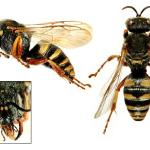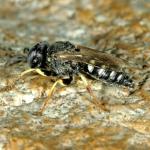Three species of Oxybelus occur in the British Isles. These wasps are superficially very similar to one another (in some localities - e.g. the Gower, West Glamorgan - they may all fly together). They are rather small, active wasps (body length 5-9 mm) with the body predominantly black with some or all of the abdominal terga marked with a pair of pale yellow or white spots. The female of O. argentatus is perhaps the most attractive of the three, its abdomen clothed with rather dense, decumbent, silvery hairs.
This species occurs very locally both on the coast (especially on dunes) and on inland heaths in southern England and west Wales. Records for Ireland are from the south-east (the Wexford coast (Stelfox 1933)). It is also known from Jersey.
Listed in Falk (1991) as Nationally Notable (Na). Atlas work has confirmed the species to be well-established in most of its historic localities.
Late June to the end of August.
Flies of the family Therevidae.
Very little is known of the nesting behaviour of O. argentatus, except that females provision their nests with dipterans, particularly therevids (often Acrosathe annulata; formerly referred to as Thereva annulata), which are carried impaled on the sting (described and illustrated by Olberg, 1959). Other aspects of its biology are likely to be broadly similar to O. uniglumis, q.v. Some observations on the nesting habits of O. argentatus are given by Boreham (1956b).
On coastal sand dunes it frequently visits sea spurge (Euphorbia paralias) and thistle (Cirsium/Carduus spp.) flowers. On an inland Hampshire heath both sexes have been found visiting biting stonecrop (Sedum acre).
1997



